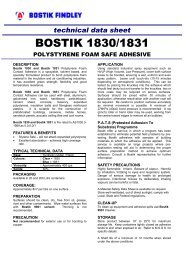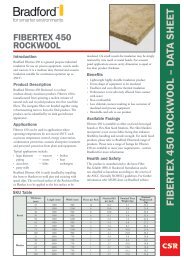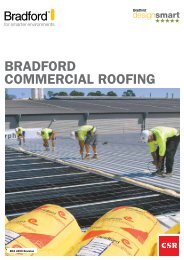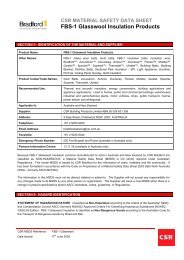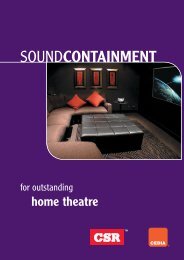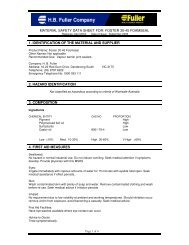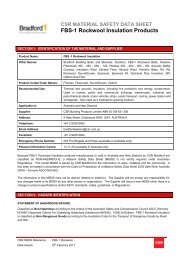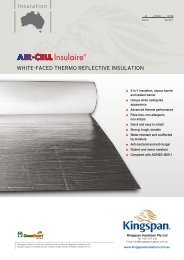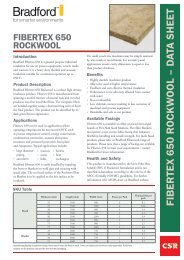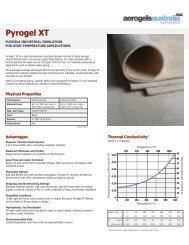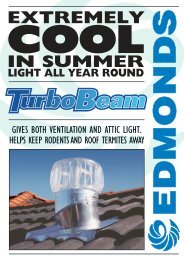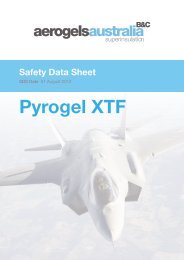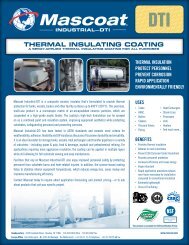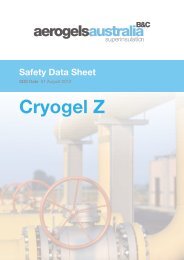AUSTHANE AUE 276 - Insulation Industries
AUSTHANE AUE 276 - Insulation Industries
AUSTHANE AUE 276 - Insulation Industries
Create successful ePaper yourself
Turn your PDF publications into a flip-book with our unique Google optimized e-Paper software.
Product Data Sheet<br />
▪ the use of polyurethane Foams in interior applications may present<br />
<strong>AUSTHANE</strong> <strong>AUE</strong><strong>276</strong><br />
an unreasonable<br />
LD Rigid Marine<br />
fire hazard<br />
Buoyancy/<br />
unless<br />
<strong>Insulation</strong><br />
an approved<br />
/ Pour<br />
fire-resistive<br />
Foam System<br />
thermal barrier protects the foam layer. Issue Date: August 2010<br />
Page 2 of 2<br />
ABYC Marine ‘Buoyancy’ Test Results<br />
ABYC Standard Test Method – Section 8.10 – Materials<br />
- Immersion in 5% Trisodium Phosphate Solution<br />
Water Temperature 25 - 29°C<br />
Immersion Time<br />
Up to 30 days<br />
Sample Density 42 kg / m³<br />
% Volume Change after 30 days<br />
ABYC Standard is a Maximum of 5%<br />
+ 1.4 % = PASS<br />
% Volume Solution Up-take [w/v] 12.3 kg / m³<br />
Change in Buoyancy Effect [ No ABYC Standard ]<br />
after 72 hours: - 2.1 % after 30 days: - 2.4 %<br />
Surface Absorption Rate after 30 days Immersion<br />
311 grams per square metre of exposed surface<br />
Water Absorption – AUS Test – see Note 1<br />
Water Temperature 25 - 29°C<br />
Exposure Time<br />
Up to 30 days<br />
Sample Density 39 kg / m³<br />
% Volume Change after 30 days<br />
No ABYC Standard<br />
No change<br />
% Volume Water Up-take [w/v] 11.6 kg / m³<br />
Change in Buoyancy Effect [ No ABYC Standard ]<br />
after 72 hours: - 1.2 % after 30 days: - 1.8 %<br />
Surface Absorption Rate after 30 days Immersion<br />
293 grams per square metre of exposed surface<br />
Note 1<br />
Testing in Tap Water does not form part of the<br />
ABYC Test requirements.<br />
Notes regarding ABYC Marine ‘Buoyancy’ Testing<br />
Under the ABYC ¹ Standards, Section H-8 –BUOYANCY IN THE<br />
EVENT OF SWAMPING sets out in Section 8.10 - Materials, the<br />
properties of materials that can be used in nominated sections<br />
of the boat.<br />
In Section 8.10.3 - Performance Specifications this sets out the<br />
requirements for Flotation material installed in and outside the<br />
engine compartment.<br />
Section 8.10.3.1 states<br />
“Flotation material installed in an engine compartment less than 12<br />
inches [ .30m ] above the lowest point where liquid can collect in<br />
that compartment [area A in Figure 16 ] when the boat is in its<br />
static floating position must not reduce in volume by more than five<br />
percent after being immersed in any of the following liquids for 30<br />
days at 84°F [29°C]. [ See the note following H-8.10.3.2.3] “<br />
Section 8.10.3.2 states<br />
“Flotation material installed outside the engine compartment [this<br />
includes inside the hull of outboard boats] less than four inches<br />
above the lowest point where liquid can collect in that<br />
compartment [area B in Figure 16 ] when the boat is in its static<br />
floating position must not reduce in volume by more than five<br />
percent after being immersed in any of the following liquids for 24<br />
hours at 84°F [29°C] [ See the note following H-8.10.3.2.3] “<br />
Limitations and Hazards<br />
In all external exposure and some internal applications the PU foam<br />
surface must be protected from weathering / physical deterioration<br />
by:<br />
• the application of a selected elastomeric membrane coating ,<br />
typically acrylic, polyurethane or bituminous types.<br />
• the application of fibreglass / Polyester Resin FRP skin.<br />
• the application of metal sheeting or other weatherproof<br />
treatment.<br />
In specific temperature and humidity conditions the effects of water<br />
vapour ‘drive’ must be considered in system design and application<br />
requirements.<br />
Special precautions need to be taken in regard to system design and<br />
specification under possible water vapour condensation<br />
temperature conditions, or in conditions where high levels of water<br />
vapour/high humidity conditions may occur.<br />
When spraying or pouring, excessive thickness should not be applied<br />
in a single application as the exotherm of the reaction may lead to<br />
spontaneous combustion, excessive pressure build up or thermal<br />
expansion from the significant heat developed in the foaming<br />
reaction.<br />
<br />
All polyurethane & polyisocyanurate foams may present a fire<br />
hazard in certain applications if exposed to fire and/or excessive<br />
heat e.g. welding, and cutting torches, in the presence of oxygen /<br />
air.<br />
Health and Safety<br />
Before using this Polyurethane System please refer to the MATERIAL<br />
SAFETY DATA SHEETS for both the Components for information on the<br />
correct handling procedures for these products and the Safety Issues and<br />
Hazards associated with their use.<br />
EXCLUSION OF WARRANTIES<br />
THESE SYSTEMS ARE NOT INTENDED FOR USE BY NON-PROFESSIONAL OR<br />
INEXPERIENCED DESIGNERS AND APPLICATORS.<br />
The information presented in this Product Bulletin requires experience and background<br />
knowledge for correct interpretation and application.<br />
The potential user must perform any pertinent tests in order to determine the<br />
product's performance and suitability in the intended application since determination<br />
of fitness of the product for any particular use is the responsibility of the buyer.<br />
The data, information and suggestions covered in this data sheet, are given on the<br />
basis that the materials will be used correctly and professionally and at the sole risk of<br />
the user.<br />
No liability is accepted by AUSTRALIAN URETHANE SYSTEMS PTY LTD, for any loss,<br />
damage arising from the use of the within information or materials described, no<br />
warranty, with expressed or implied, is given as to the exclusion from any patents or as<br />
to the fitness of the goods described for any particular purpose and each application<br />
should be fully evaluated to the satisfaction and acceptance of the user, in particular as<br />
to the combustibility or flammability or toxicity of material generated by combustion of<br />
the products herein described or materials produced from these products.<br />
1<br />
Under Items H - 8.10.3.1.3 and H - 8.10.3.2.3, the nominated Test Liquid<br />
is a five percent aqueous solution of Trisodium Phosphate.<br />
This solution is generally referred to as a ‘Bilge Cleaner’.<br />
AUSTRALIAN URETHANE SYSTEMS PTY LTD www.ausurethane.com A.C.N. 000 168 874 A.B.N. 50 000 168 874<br />
Sydney Office 25 Garling Road Kings Park NSW 2148 Phone (02) 9678 9833 Facsimile 1800 887 666<br />
Brisbane Office Suite 64 | 283 Given Terrace Paddington QLD 4064 Phone (07) 3876 5300 Facsimile (07) 3876 5311<br />
Melbourne Office Unit 32 | 9 Ashley Street Footscray 3012 Phone 0411 690 565 Facsimile 1800 887 666



